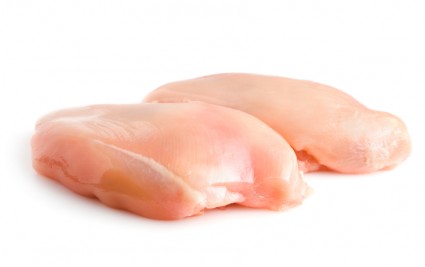 Why is Big Ag playing chicken with our health?Back in March, Tom Philpott wrote about the “insane” practice of feeding factory-farmed chickens arsenic:
Why is Big Ag playing chicken with our health?Back in March, Tom Philpott wrote about the “insane” practice of feeding factory-farmed chickens arsenic:
The idea is that it makes them grow faster — fast growth being the supreme goal of factory animal farming — and helps control a common intestinal disease called coccidiosis.
The industry emphasizes that the arsenic is applied in organic form, which isn’t immediately toxic. “Organic” in the chemistry sense, that is, not the agricultural sense — i.e., molecules containing carbon atoms as well as arsenic. Trouble is, arsenic shifts from organic to inorganic rather easily. Indeed, “arsenic in poultry manure is rapidly converted into an inorganic form that is highly water soluble and capable of moving into surface and ground water,” write Keeve E. Nachman and Robert S. Lawrence of the Johns Hopkins Center for a Livable Future.
Inorganic arsenic is the highly poisonous stuff — see the absurd and wonderful Cary Grant classic Arsenic and Old Lace, or the EPA’s less whimsical take here and here [PDF]. The fact that the organic arsenic added to feed turns inorganic when it makes its way into manure is chilling, given the mountains of concentrated waste generated by factory poultry farms.
One way farmers add arsenic to chicken feed is through drugs such as Pfizer’s Roxarsone. And the industry has (as with most of its worst practices) strenuously defended the use of such additives. While the USDA has by and large ignored the risks (mostly in the form of an unwillingness to look for arsenic in chicken), finally — astonishingly — the FDA has acted.
According to the Associated Press, the FDA has confirmed that chickens given the drug (frequently those destined for the low-cost supermarket shelf) do indeed test positive for inorganic arsenic — just as the Institute for Agriculture and Trade Policy found [PDF] back in 2006. Despite this earlier evidence, the industry had continued to steadfastly maintain that the arsenic could not and did not make it into the meat.
As part of its announcement, the FDA said the arsenic levels are low and represent no meaningful risk to those eating Roxarsone-treated chicken — a point predictably emphasized by the National Chicken Council.
Tellingly, Pfizer announced that it would withdraw Roxarsone from the market starting next month. The FDA didn’t order Pfizer to withdraw the drug — the company did so voluntarily.
Of course, this does not solve the problem of arsenic in chicken. As Michael Hansen of Consumers Union observed in a press release, “There are several other arsenic-containing drugs for animals that are on the market, and those should also be withdrawn or banned, as they have been in the European Union.”
As Food & Water Watch reported in March, “between 2000 and 2008, the USDA tested only 1 out of every 12 million domestically produced chickens.” So it’s not as if the government is tracking this problem in any systematic way.
It boggles my mind that the industry is so willing to risk consumer panic over this issue and wait for the media or government officials to force its hand. Instead of making smart business decisions and ending dangerous practices that might give consumers cause to avoid their product, they instead try to hold back the tide. One drug gets withdrawn while others remain. The FDA tests 100 chickens (as they did in this latest test), while millions are produced and sold every year.
It’s no wonder that the so-called “ag-gag” bills remain popular among industrial farmers and their political lackeys. They can’t seem to let go of consumer ignorance as a key business strategy. With arsenic in chicken, the FDA, the USDA, and the chicken industry seem to care far more about the perception of having acted rather than the reality of ensuring all chicken sold in the U.S. is free from this toxic substance.



